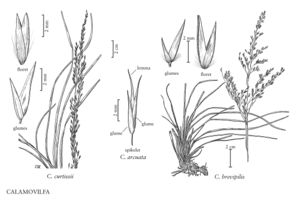Difference between revisions of "Calamovilfa arcuata"
imported>Volume Importer |
imported>Volume Importer |
||
| Line 43: | Line 43: | ||
|publication year= | |publication year= | ||
|special status=Endemic | |special status=Endemic | ||
| − | |source xml=https://bitbucket.org/aafc-mbb/fna-data-curation/src/ | + | |source xml=https://bitbucket.org/aafc-mbb/fna-data-curation/src/200273ad09963decb8fc72550212de541d86569d/coarse_grained_fna_xml/V25/V25_707.xml |
|subfamily=Poaceae subfam. Chloridoideae | |subfamily=Poaceae subfam. Chloridoideae | ||
|tribe=Poaceae tribe Cynodonteae | |tribe=Poaceae tribe Cynodonteae | ||
Latest revision as of 17:58, 11 May 2021
Rhizomes short, covered with the persistent bases of the foliage leaves. Culms to 1.5+ m. Sheaths to 22 cm; ligules to 0.7 mm; blades to 85 cm long, 1.5-6.5 mm wide. Panicles 15-45 cm long, 8-40 cm wide, open; branches to 22 cm, ascending to spreading. Spikelets 6-7.4 mm. Glumes usually arcuate, acute to acuminate; lower glumes 2.7-4.1 mm; upper glumes 4.2-5.4 mm; callus hairs 1/3 – 1/2 as long as the lemmas; lemmas 5.5-7 mm, arcuate, pubescent, attenuate; paleas 5.4-6.2 mm, pubescent; anthers 2.8-3.2 mm. 2n = unknown.
Distribution
Tenn., Ky., Ark., Okla., Ala.
Discussion
Calamovilfa arcuata is known only from a few scattered locations in the south central United States. It grows along streams and rivers.
Selected References
None.
Lower Taxa
None.
